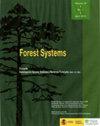Morphological descriptors for the characterization of teak clones (Tectona grandis L.f.) in plantations
IF 0.7
4区 农林科学
Q3 FORESTRY
引用次数: 2
Abstract
Aim of study: The objective of this work was to identify possible morphological descriptors for teak clones, in order to support the cultivars protection process of this species.Area of study: This experiment was carried out in ‘São José dos Quatro Marcos’, Mato Grosso, midwest Brazil.Material and methods: A teak clonal test, assessing 18 clones, was evaluated at the ages of 29 and 41 months by means of 41 morphological characteristics, related mainly to the branches, leaves and trunk. The clonal test was established in a randomized block design composed by three blocks, each block containing 18 plots, one for each clone. Each plot had 36 plants, but only the innermost five individuals were selected and evaluated. The information was organized in a presence and absence matrix. Subsequently, genetic similarity measures were estimated, by means of the Jaccard index, and a clustering was performed by the Unweighted Pair Group Method using the Arithmetic averages (UPGMA) method.Main results: A total of 26 and 28 morphological characteristic that exhibited DHS (distinction, homogeneity and stability) were identified at the ages of 29 and 41 months, respectively. Of these, 17 characteristics showed the same behavior at 29 and 41 months of age. However, it is important to emphasize that the evaluation must be performed under the same planting conditions in which these descriptors were developed.Research highlights: These 17 morphological characteristics can compose the list of potential morphological descriptors to be used in the process of teak clones/cultivars protection.Keywords: cultivars protection; morphological characteristics; distinction, homogeneity; stability.人工林柚木无性系特征的形态学描述符
研究目的:本工作的目的是确定柚木无性系的可能形态描述符,以支持该物种的品种保护过程。研究领域:本实验在巴西中西部马托格罗索的“São Josédos Quatro Marcos”进行。材料和方法:在29个月和41个月大时,通过41个主要与枝条、叶片和树干有关的形态特征,对18个柚木无性系进行了评估。克隆试验是在由三个区块组成的随机区块设计中建立的,每个区块包含18个区块,每个克隆一个。每个小区有36株植物,但只选择和评估了最里面的5株。信息被组织成在场和缺席矩阵。随后,通过Jaccard指数估计遗传相似性度量,并通过使用算术平均值(UPGMA)方法的未加权配对组方法进行聚类。主要结果:在29个月龄和41个月龄时,共鉴定出26个和28个表现出DHS的形态特征(差异性、同质性和稳定性)。其中,17个特征在29个月和41个月大时表现出相同的行为。然而,需要强调的是,评估必须在开发这些描述符的相同种植条件下进行。研究亮点:这17个形态特征可以构成柚木克隆/品种保护过程中使用的潜在形态描述符列表。关键词:品种保护;形态特征;区别性、同质性;稳定性
本文章由计算机程序翻译,如有差异,请以英文原文为准。
求助全文
约1分钟内获得全文
求助全文
来源期刊

Forest Systems
FORESTRY-
CiteScore
1.40
自引率
14.30%
发文量
30
审稿时长
6-12 weeks
期刊介绍:
Forest Systems is an international peer-reviewed journal. The main aim of Forest Systems is to integrate multidisciplinary research with forest management in complex systems with different social and ecological background
 求助内容:
求助内容: 应助结果提醒方式:
应助结果提醒方式:


